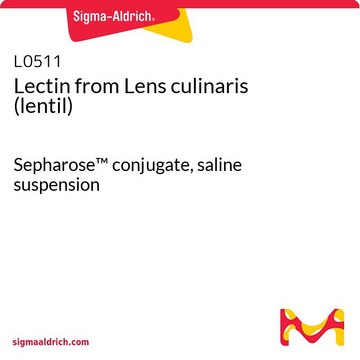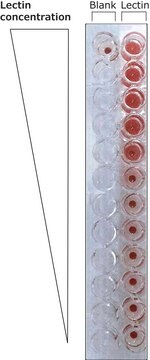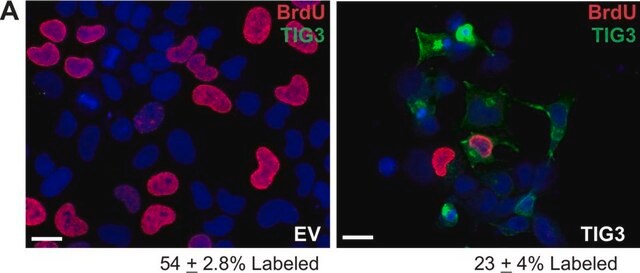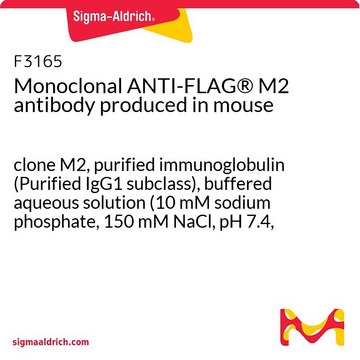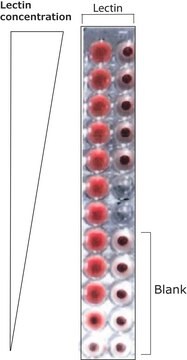L0401
Lectin from Lycopersicon esculentum (tomato)
FITC conjugate, buffered aqueous solution
Sinônimo(s):
Lycopersicon esculentum agglutinin, LEA
Faça loginpara ver os preços organizacionais e de contrato
About This Item
Código UNSPSC:
12352202
NACRES:
NA.32
Produtos recomendados
conjugado
FITC conjugate
Nível de qualidade
Formulário
buffered aqueous solution
Extensão da rotulagem
2.0-6.0 mol FITC per mol lectin
temperatura de armazenamento
2-8°C
Procurando produtos similares? Visita Guia de comparação de produtos
Descrição geral
Lectins are carbohydrate binding proteins. Lectin from Lycopersicon esculentum (LEA) binds strongly to polylactosamine oligosaccharides. It is the major component of endothelial and epithelial cell surface carbohydrate.
Aplicação
Lectin from Lycopersicon esculentum (tomato) has been used:
- for immunofluorescence staining
- for the quantification of vascular perfusion
- for the evaluation of gel perfusion efficiency
Ações bioquímicas/fisiológicas
LEA is not blood group specific, but has an affinity for N-acetyl-β-D-glucosamine oligomers. The lectin is a glycoprotein containing approx. equal amounts of protein and carbohydrate and is reported to inhibit the mitogenic activity of phytohemagglutinin from Phaseolus vulgaris. This lectin binds endothelial cells and is used to visualize the microvasculature.
Lectin has anti-cancer, anti-human immunodeficiency virus (anti-HIV), anti-microbial infection and blocks mucosal atrophy. It reduces type 2 diabetes and obesity, stimulates nutrient absorption and drug targeting. It is used to stain the vascular tree in the spinal cord and brain of animals. Lectin agglutinates cells and precipitates polysaccharides and glycoproteins.
Embalagem
Sold on the basis of mg active conjugate.
forma física
Solution in 10 mM HEPES, 0.15 M NaCl, pH 7.5, containing 0.1 mM Ca2+, 0.08% sodium azide and 5 mg/mL β-cyclodextrin.
Nota de análise
Agglutination activity is expressed in μg/ml and is determined from serial dilutions in phosphate buffered saline, pH 7.3, of a 1 mg/ml solution. This activity is the lowest concentration to agglutinate a 2% suspension of human erythrocytes after 1 hour incubation at 25 °C.
Código de classe de armazenamento
12 - Non Combustible Liquids
Classe de risco de água (WGK)
WGK 2
Ponto de fulgor (°F)
Not applicable
Ponto de fulgor (°C)
Not applicable
Escolha uma das versões mais recentes:
Já possui este produto?
Encontre a documentação dos produtos que você adquiriu recentemente na biblioteca de documentos.
Os clientes também visualizaram
Melatonin suppresses toll like receptor 4-dependent caspase-3 signaling activation coupled with reduced production of proinflammatory mediators in hypoxic microglia
Yao L, et al.
PLoS ONE, 11(11), e0166010-e0166010 (2016)
Lycopersicon esculentum lectin: an effective and versatile endothelial marker of normal and tumoral blood vessels in the central nervous system
Mazzetti S, et al.
European Journal of Histochemistry, 48(4), 423-428 (2009)
Lectin conjugates as biospecific contrast agents for MRI. Coupling of Lycopersicon esculentum agglutinin to linear water-soluble DTPA-loaded oligomers
Pashkunova-Martic I, et al.
Molecular Imaging and Biology : MIB : The Official Publication of the Academy of Molecular Imaging, 13(3), 432-442 (2011)
Loss of serglycin promotes primary tumor growth and vessel functionality in the RIP1-Tag2 mouse model for spontaneous insulinoma formation
Hamilton A, et al.
PLoS ONE, 10(5), e0126688-e0126688 (2015)
Alba Grayston et al.
Journal of cerebral blood flow and metabolism : official journal of the International Society of Cerebral Blood Flow and Metabolism, 42(2), 237-252 (2021-07-08)
The increasing use of mechanical thrombectomy in stroke management has opened the window to local intraarterial brain delivery of therapeutic agents. In this context, the use of nanomedicine could further improve the delivery of new treatments for specific brain targeting
Nossa equipe de cientistas tem experiência em todas as áreas de pesquisa, incluindo Life Sciences, ciência de materiais, síntese química, cromatografia, química analítica e muitas outras.
Entre em contato com a assistência técnica

